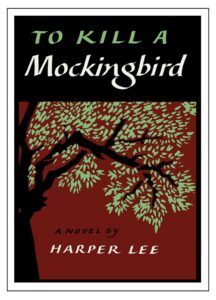Although it doesn’t really need promoting, to kick off the new year, I want to revisit a classic that remains high on my list of favorite books. A powerful portrait of racism (and “otherism”) in the 1930s, To Kill A Mockingbird is a book I turn to for its fine writing, its rich characters, its powerful story, and its morality. Harper Lee still makes me laugh, makes me cry, makes me mad, frightens me, and breaks my heart.
I was first exposed to the movie, which came to television when I was a preteen. I loved Scout and Jem and Atticus, of course, and was fascinated by the Boo Radley story, especially since we’d had Old Hairy,* our own neighborhood Boo, our own “other”. But the character that haunted me was Tom Robinson.
What stayed with me was the scared feeling that came with wondering if someone I loved could so easily be wrongly accused and wrongly convicted, even with a lawyer as competent and courageous as Atticus Finch.
Later, when I read Harper Lee’s novel, I fell head over heels for it.
Now, as an adult, when I consider Tom Robinson—his victimization—when I consider Atticus and Jem, Scout and Boo, when I consider the heart of this book, I wonder what today’s young readers come away with. I can’t control how others experience Mockingbird (or any book), and I wouldn’t want to, but my hope is that readers will, on some level, recognize the moral core that gives each of us the will to do what’s right, regardless of outcome.
Harper Lee’s work burrowed into my soul, took up residence, and continues to reveal its presence. To Kill a Mockingbird is a book well worth reading and re-reading for soul searching and deep discussion, but mostly to laugh, to cry, to get mad, to get scared, and to get your heart broken—in a good way.
##
* A character in Mayfield Crossing by Vaunda Micheaux Nelson (G. P. Putnam’s Sons, 1993)

